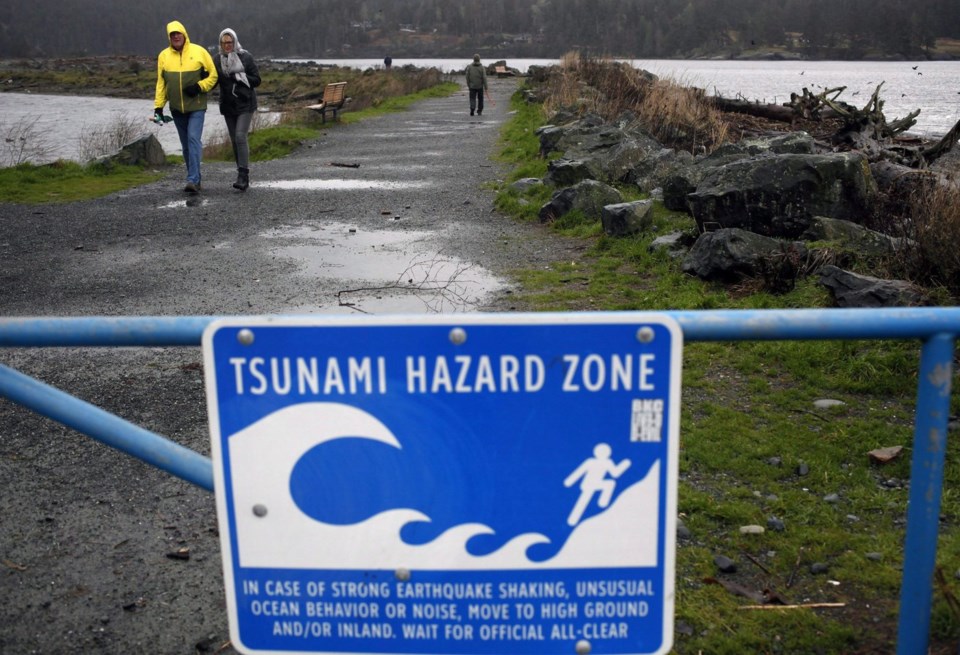Most of British Columbia's coast is under a tsunami advisory, triggered when one of the biggest earthquakes ever recorded struck off the coast of southeastern Russia.
The province's emergency information agency had said tsunami waves less than 30 centimetres high were forecast to reach Tofino, B.C., around 11:30 p.m. Tuesday, but there's been no immediate confirmation the waves have arrived.
Emergency Info BC said waves were expected in a series, "and the first may not be the biggest," and it's encouraging people in affected areas to stay away from the shoreline.
The District of Tofino said all beaches were closed until further notice.
The massive quake with a preliminary magnitude of 8.8 set off tsunami advisories and warnings around the Pacific, with the U.S. National Tsunami Warning Centre saying waves higher than three metres are possible in parts of Hawaii, Ecuador and Russia.
Signs alerting people about the tsunami advisory were posted at Wickaninnish Beach in Pacific Rim National Park, southeast of Tofino, but people continued to take in the sunset, although the parking lot was mostly empty.
Campers at the JX Surf Shop campground between Tofino and Ucluelet on Vancouver Island were glued to their phones Tuesday night searching for the news about the tsunami. But most campers appeared to be staying put for the night.
The waves had been expected to reach B.C. around 10:05 p.m. at remote Langara Island at the northern tip of Haida Gwaii.
If the preliminary magnitude is confirmed, the quake would be among the 10 most powerful recorded since 1900, and the most powerful since the devastating 2011 Tohoku earthquake off Japan, according to a list compiled by the U.S. Geological Survey.
Multiple aftershocks with one as strong as 6.9 in magnitude were recorded on Tuesday.
Japan's Meteorological Agency said a tsunami as high as 60 centimetres had been detected as waves from the Russian quake moved south along the Pacific coast from Hokkaido to Tokyo Bay.
The tsunami advisory was in effect for most of B.C.'s coast, including Greater Victoria.
The affected B.C. zones included the North Coast and Haida Gwaii, the Central Coast and northeastern Vancouver Island, including Kitimat, Bella Coola and Port Hardy, and the outer west coast of Vancouver Island from Cape Scott to Port Renfrew.
The tsunami advisory also covered the Juan de Fuca Strait from the Jordan River area to Greater Victoria, including the Saanich Peninsula. But it did not include the Strait of Georgia, Gulf Islands, Johnstone Strait or Greater Vancouver.
The U.S. National Tsunami Warning Center said a tsunami advisory was the second of three levels used by the United States and Canada. A tsunami warning — the highest level — was in place for coastal areas near the Oregon-California border.
Emergency Info BC had said local governments in affected areas were being urged to activate emergency plans and consider evacuating marinas, beaches and other areas near the ocean.
An advisory posted by Environment Canada, meanwhile, said there was a "possibility of strong localized currents."
It said no significant inundation was expected, but low-lying coastal areas and beaches may be at risk.
The weather agency said people in coastal areas were advised to stay away from the shoreline and stay alert for any instructions from emergency authorities.
The quake struck just before 4:25 p.m. Pacific time on Tuesday, occurring about 119 kilometres east-southeast of Petropavlovsk-Kamchatsky, a city of about 180,000 residents in Russia's Kamchatka region.
Russian news agencies reported damage and evacuations in areas nearest the quake's epicentre on the Kamchatka peninsula, but no serious injuries.
There were reports from Petropavlovsk-Kamchatsky that people had run out into the street without shoes or outerwear, while cabinets toppled inside homes, mirrors were broken, cars swayed in the street, and balconies on buildings shook.
Tsunami warning sirens blared in Honolulu, where people were told to move to higher ground after the quake.
Hawaii Gov. Josh Green said data from Midway Atoll, which is between Japan and Hawaii, measured waves from peak to trough of 1.8 metres.
The impact of the tsunami could last for hours or perhaps more than a day, said Dave Snider, tsunami warning coordinator with the U.S. National Tsunami Warning Center in Alaska
"A tsunami is not just one wave," he said. "It's a series of powerful waves over a long period of time. Tsunamis cross the ocean at hundreds of miles an hour — as fast as a jet airplane — in deep water. But when they get close to the shore, they slow down and start to pile up. And that's where that inundation problem becomes a little bit more possible there."
— With files from Dirk Meissner, Wickaninnish Beach, and The Associated Press
This report by The Canadian Press was first published July 29, 2025.
Brenna Owen, The Canadian Press




